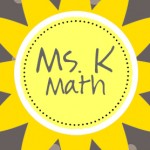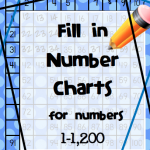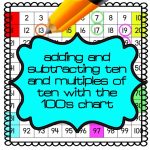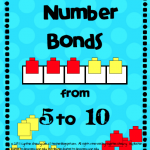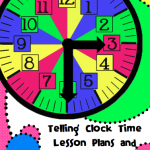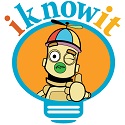How Do You Help Students Who Struggle with Number Sense?
While working closely with students in intervention groups in 3rd, 4th, and 5th grades the obvious has dawned on me. Students struggle with their understanding of many number concepts such as adding, subtracting, and rounding simply because they cannot count forwards and/or backwards from any number. Their understanding of patterns to count eludes them. Maybe implementing the new common core standards helped me to see this more clearly. Having your students simply count orally or write their numbers as a daily activity starting at any random number, will help strengthen their number “common sense” as I like to call it. Looking at number charts and identifying patterns as a matter of daily practice will aide in strengthening their number sense.
To build a solid foundation with students in grades K-2 and to intervene on behalf of some students in grades 3-5, I made a variety of number charts and puzzles for the purpose of helping students become strong with their sense of number. Several of these charts begin ten numbers before a multiple of 100, and continue counting 10 numbers after a multiple of 100 is reached. This is in order that students are able to practice identifying what numbers come before multiples of 100 which I have especially noticed my intervention groups struggle with. My plan is to make the charts go to 1000, however it was taking me so long to build the number puzzles that I decided to complete charts and puzzles in sections. This first group goes to 310. They are for sale on TPT now. I am posting some examples of the charts and puzzles below. Just click on them if you are interested in purchasing them.
Free Family Math Night Punch Cards
Since I am planning a Family Math Night in January, I thought I would share my PunchCardsforParentNight with you. We will be having several stations set up for students and parents. They must attend at least five stations to enter to win for a door prize and for the evening meal. Hope you can use it for whatever family night you will be having. I am posting it in Word format so that you can adapt it to suit your needs. I hope that the formatting turns out okay.
What Does Modeling with Mathematics Really Mean?
Keep it REAL! This fourth common core standard for mathematical practice could be summed up in that statement. Modeling with Mathematics doesn’t quite mean pull out the snap cubes, color tiles, and pattern blocks. The essence of this standard is to create problem solving experiences for students that they will encounter in real life. Some practical problem solving experiences could include:
- If I have to put 2/3 cups of flour in the recipe and I need to double the recipe, how many times do I need to fill a 1/3 measuring cup to put enough flour in the doubled recipe?
- Which cell phone data and calling package is the best buy?
- What time do I need to wake up for school to get dressed and be there fifteen minutes early?
- If I can only spend 25% of my income on renting a house, how much money do I need to make to rent a house that is $500 a month? $600? $900?
- How could you create a floor plan for a house with 1428 square feet?
- If a certain medicine is shown to be effective 33% of the time, should it be used to treat an illness?
What Does it Mean for Students to Construct a Viable Argument and Critique the Reasoning of Others?
To create an environment for this third standard of mathematical practice, a teacher must create a safe environment where students’ do not fear risks and where it is okay for them to be wrong. In our current school culture most students do not feel comfortable being wrong for fear of being laughed at or belittled by their peers or worse–maybe the teacher. This culture must be replaced by the idea that everyone’s thinking is worth examining either for why it is correct or incorrect. For students, gone is the day when they simply agree or disagree with someone’s answer–might I add usually following the tone of the teacher’s voice to know if the answer is correct. Students must be able to explain why they agree or disagree.
We must value each student’s response. Instead of getting an answer and moving on, teachers should collect the thinking of at least several students and ask if the answers are reasonable or unreasonable. For example, for the problem 14 x 3, a teacher might go around the room and gather the answers 17, 34, 32, 42, and 44. The teacher can ask students which answers are unreasonable and why.
A student who is critiquing the reasoning of other with a viable argument might say something like:
“Well, I know that 17 can’t be correct because if you add 10 twice that makes 20 and fourteen is more than 10 and 20 is more than 17, so 17 couldn’t be correct. Also, I think they accidentally added because 14 plus 3 is seventeen.”
In the above case the student who gave the incorrect answer is not named because no one remembers who gave the response 17. Since 17 is written on the board as a response and no name is written by the response the answer is viewed merely as something to discuss. The student, however, who gave the response 17 is most likely intently listening because he gave the response. Further, the student answering 17 may have even recognized his mistake when the teacher wrote all of the responses on the board and saw how his was far from other students’ answers.
A practical approach of a student constructing a viable argument for his correct answer might sound something like this after being asked what is 14 x 3?
“I know the answer is 42 because I used the distributive property to multiply my tens first and then my ones. I broke the fourteen into one ten and four ones. Then I multiplied the ten times three and I got thirty. Next, I multiplied the three ones and the four ones and got twelve. Then I added thirty and twelve and got 42.
I know what you are thinking, “My students wouldn’t say all of that!” BUT, if you praise and expect this behavior, you will be surprised at what your students will be able to explain by the end of the year. Eventually you will no longer prompt students to go beyond the answer “42”, they will be explaining their reasoning without being asked.
Merry Christmas Everyone!
I wish you all a very Merry Christmas, and since it is Christmas, I will share an excerpt from my favorite Christmas book. I have made it somewhat of my own personal tradition to read this story every year at Christmas time to anyone who will listen, and I especially love to read the story to children!
“And I thought about the Angel of the Lord–Gladys, with her skinny legs and her dirty sneakers sticking out from under her robe, yelling at all of us, everywhere: ” Hey! Unto you a child is born!” –The Best Christmas Pageant Ever by Barbara Robinson
I hope you will enjoy this story, too!
How Do You Encourage Students’ to Make Sense of Problems and Persevere in Solving Them?
Making Sense of Problems and Persevere in Solving Them is the first of the Eight Mathematical Practices of Common Core. Because this is a practice that needs to be fostered in students and is not easily modeled by teachers, it is one of the more difficult practices to develop in students. Teachers tend not to model problem solving, but they model a method or a strategy to find a solution. Making Sense of Problems and Persevering in Solving them kisses the old “direct modeling” lesson plans goodbye.
Instead of direct modeling, teachers should provide students with rich tasks that help students discover the content they are trying to teach. A good example of this is in one of the TERC math investigations books in which students are given several nets and asked to find the number of cubes needed to fill the net. Students then are asked to make a generalization about how to find the number of cubes needed to fill a net. After this task students devise their own way to calculate the volume of a figure. Students will have different methods to finding the volume of a figure, and this gives place for student voice and higher level questioning and discussion. Then the teacher may lead students into the conventional volume formula after students have found it for themselves.
Instead of direct modeler, the teacher takes on more of a facilitator role. The teacher is responsible for giving students rich, engaging tasks that will guide them into discovering the math content they are trying to teach. Math class then becomes engaging because of its core of students’ discovery through problem solving, and the learning becomes their own. Teachers’ role is to provide students with mathematical vocabulary, notation, and convention to express their found ideas. Teachers should also formatively assess students throughout their learning to gauge the level of challenge that they need to provide for their students. When a teacher becomes skilled at providing rich lessons for the students, then the students persevere because their interest level is heightened.
What’s the Difference in Reasoning Abstractly and Quantitatively?
I recently attended a fabulous professional development which discussed the Eight Mathematical Practices for Common Core Standards. One of these practices is having students reason abstractly and quantitatively. I have always required students to label the answers to their equations when supporting an open ended question, but I didn’t realize the depth of what I was requiring. Consider this. Which is more– 5 or 8? We would all agree that 5<8. This is an example of reasoning abstractly. Now, consider this. Which is more–5 quarters or 8 pennies? We would all agree that 5 quarters > than 8 pennies. This is an example of reasoning quantitatively. When students answer a word problem by labeling each component of their equation, they are reasoning quantitatively. When students merely solve a “naked numbers” problem without labeling the quantities with which they are reasoning , then they are reasoning abstractly. When students are reasoning with specific quantities, then the foundation being built is stronger for them to then build abstractly. Just think. The math textbooks are backwards. Quantitative reasoning problems follow abstract reasoning, however students understanding is built first with quantitative problems and should be followed with abstract understanding.
Do You Need an App for Almost Any Discipline?
Use this link for almost any app you can think of. The link will take you to a nearly exhaustive chart of all types of educational apps sorted by discipline. Some of them are free and some are not. These would be great to compile a list for your students’ parents or to use in the classroom if your school has access to ipods or ipads.
